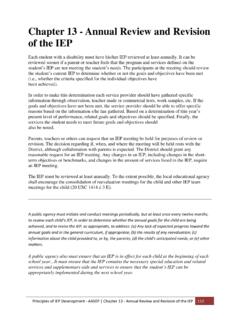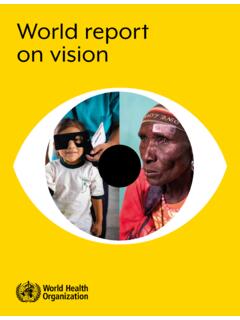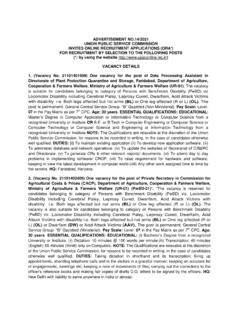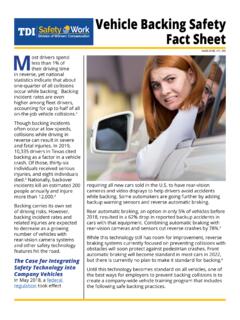Transcription of Chapter 3 - Deaf-Blindness - AASEP
1 SPECIAL EDUCATION ELIGIBILITY AASEP | Chapter 3 deaf blindness 25 Chapter 3 - Deaf-Blindness Definition under IDEA of Deaf-Blindness Deaf-Blindness refers to concomitant hearing and visual impairments, the combination of which causes such severe communication and other developmental and educational needs that they cannot be accommodated in special education programs solely for students with deafness or students with blindness . Overview of Deaf-Blindness The majority of students who have both visual and hearing impairments at birth experience major difficulties in acquiring communication and motor skills, mobility, and appropriate social skills. Because these individuals do not receive clear and consistent information from either sensory modality, a tendency exists to turn inward to obtain the desired level of stimulation.
2 The individual therefore may appear passive, non-responsive, and/or non-compliant. Students with Deaf-Blindness (also referred to as dual sensory impairments) may not respond to or initiate appropriate interactions with others and often exhibit behavior that is considered socially inappropriate. Deaf-Blindness is a combination of vision and hearing loss, not necessarily complete deafness and complete blindness . There is a wide range of thinking and developmental ability among deaf - blind individuals from gifted to profoundly multiply handicapped. Deaf-Blindness creates additional problems in the areas of mobility and communication, as well. (California deaf - blind Services). Individuals who are deaf - blind need early intervention and personal attention to stimulate their understanding and interest in the world around them.
3 The information that most students pick-up naturally must be deliberately introduced to students with dual sensory impairments. Effective programs for infants and toddlers with Deaf-Blindness are both student-and family-centered. Student-centered approaches focus on meeting the student s individual needs, while a family centered approach focuses on the student as a member of the family unit. The needs, structure, and preferences of the family will often drive the delivery of the early intervention services (Ramey & Ramey). Communication and mobility are often the most affected areas of life for a person with deaf - blindness causing feelings of isolation and loneliness. Development of compensatory skills can help bridge this gap.
4 Trainings and instructional strategies are available to parent/guardians and educators relative to communication and mobility. (California deaf - blind Services). 26 Chapter 3 deaf blindness | SPECIAL EDUCATION ELIGIBILITY AASEP Prevalence of Deaf-Blindness According to the Department of Education, Deaf-Blindness represents less than percent of all students having a classification in special education. Characteristics of Students with Deaf-Blindness According to the deaf blind Services Division, Utah Schools for the deaf and the blind ( ) Depending on the age of onset, deaf blindness can affect learning in the areas of cognition, communication, social interaction, motor skills, and motivation. Indicators of Deaf-Blindness include: The student has difficulty with communication The student may have distorted perceptions.
5 It is difficult to see the whole picture or relate one element to the whole. The student may have difficulty anticipating what is going to happen. Clues from the environment or from the faces/actions of others may be difficult to read. The student-may be somewhat unmotivated. Things may not be seen or heard enough to be desirable. The student needs to learn mainly through first hand experiences. The lack of vision and hearing make it hard to learn through incidental or group learning experiences. Problems communicating Problems navigating the environment Procedures and Assessment Measures used to diagnose deaf blindness If a student is suspected of having Deaf-Blindness , an evaluation for both a visual impairment and hearing impairment shall be conducted: Evaluation for a visual impairment should include the following: 1.
6 Evaluation by an ophthalmologist or optometrist, which documents the eye condition with the best possible correction 2. a written functional vision and media assessment, completed or compiled by a licensed teacher of students with Visual Impairments, which includes: observation of visual behaviors at school, home, or other environments educational implications of eye condition based upon information received from eye report assessment and/or screening of expanded core curriculum skills (orientation and mobility, social interaction, visual efficiency, independent living, recreation and leisure, career SPECIAL EDUCATION ELIGIBILITY AASEP | Chapter 3 deaf blindness 27 education, assistive technology, and compensatory skills)
7 As well as an evaluation of the student s reading and writing skills, needs, appropriate reading and writing media, and current and future needs for Braille school history and levels of educational performance documentation and assessment of how Visual Impairment adversely affects educational performance in the classroom or learning environment. Evaluation for a hearing impairment should include the following: (A) An audiological assessment by an audiologist licensed by a State Board of Examiners in Speech Pathology and Audiology; (B) A medical statement or a health assessment statement indicating whether the hearing loss, if conductive, is treatable and whether the use of amplification is contra-indicated; (C) Assessments to determine the impact of the suspected disability: (i) On the student's educational performance when the student is at the age of eligibility for kindergarten through age 21, or (ii) On the student's developmental progress when the student is age three through the age of eligibility for kindergarten.
8 Besides these assessment measures, the following should be considered: If a student is suspected of having Deaf-Blindness under the definition set forth in IDEA, the following assessment measures should also be considered: An observation by a team member other than the student s general education teacher of the student s academic performance in a general classroom setting; or in the case of a student less than school age or out of school, an observation by a team member conducted in an age-appropriate environment A developmental history, if needed An assessment of intellectual ability Other assessments of the characteristics of speech and language impairments if the student exhibits impairments in any one or more of the following areas: cognition, fine motor, perceptual motor, communication, social or emotional, and perception or memory.
9 These assessments shall be completed by specialists knowledgeable in the specific characteristics being assessed: A review of cumulative records, previous individualized education programs or individualized family service plans and teacher collected work samples 28 Chapter 3 deaf blindness | SPECIAL EDUCATION ELIGIBILITY AASEP If deemed necessary, a medical statement or health assessment statement indicating whether there are any physical factors that may be affecting the student s educational performance Assessments to determine the impact of the suspected disability: On the student s educational performance when the student is at the age of eligibility for kindergarten through age 21 On the student s developmental progress when the student is age three through the age of eligibility for kindergarten Additional evaluations or assessments necessary to identify the student s educational needs.
10 Eligibility for a Diagnosis of Deaf-Blindness In order to identify and be determined as eligible for special education services as a student with Deaf-Blindness , the IEP Committee shall document that the following standards have been met. The IEP Committee has determined that the student meets the eligibility criteria for special education as a student with vision impairment. AND The IEP Committee has determined that the student meets the eligibility criteria for special education as a student with hearing impairment. Or The student meets eligibility criteria for either hearing or vision impairment, but demonstrates inconclusive or inconsistent responses in the other sensory area. A functional assessment in the other sensory area substantiates the presence of an impairment in that area; Or The student meets the minimum criteria for either hearing or vision impairment and has a degenerative disease or pathology that affects the acuity of the other sensory area.










